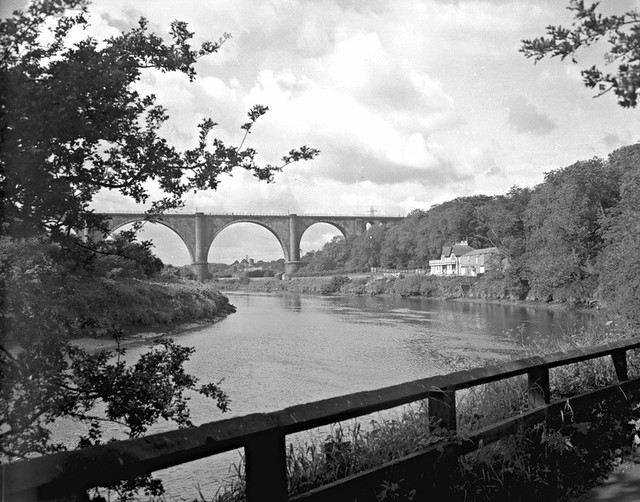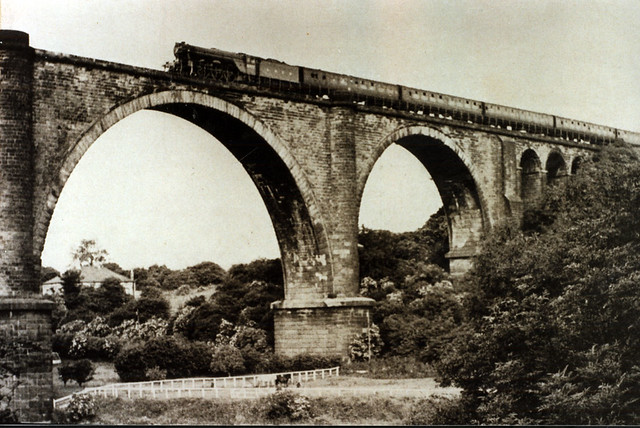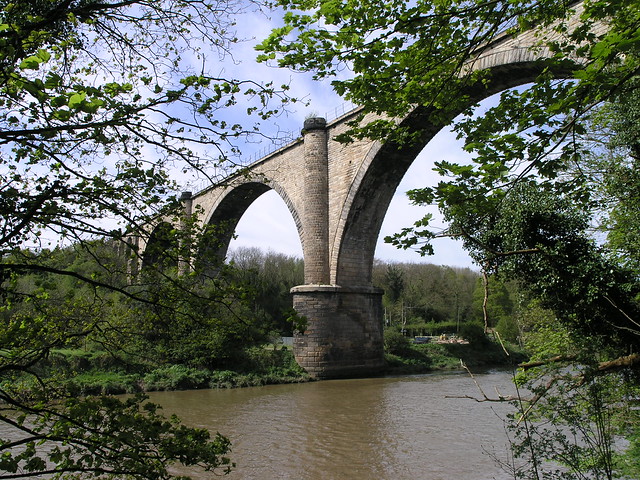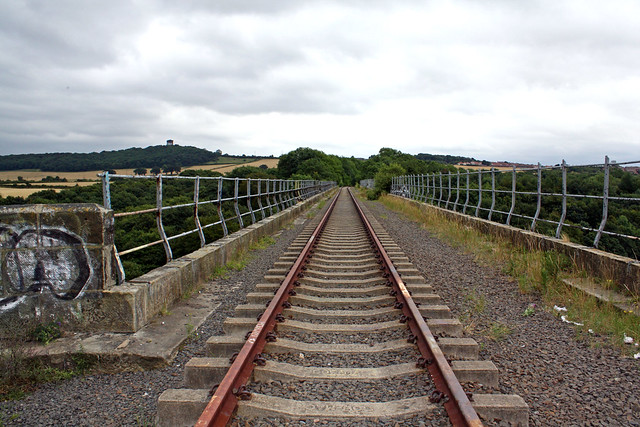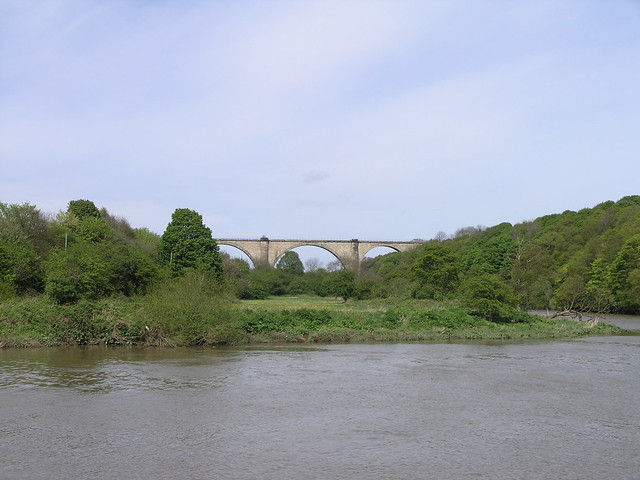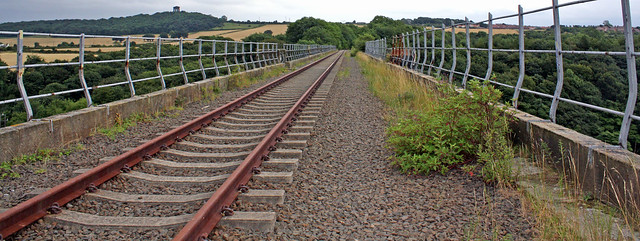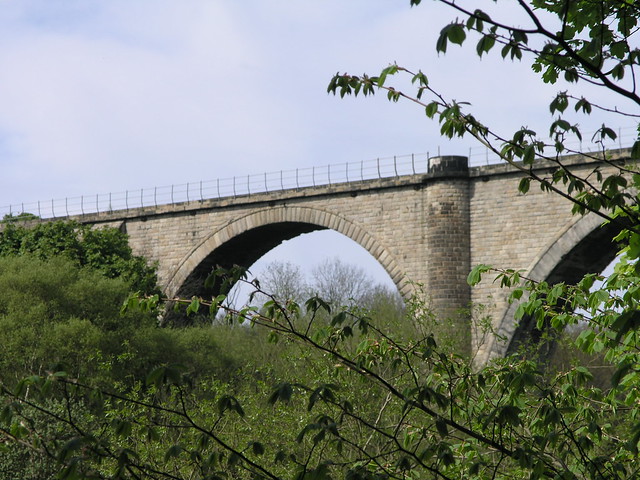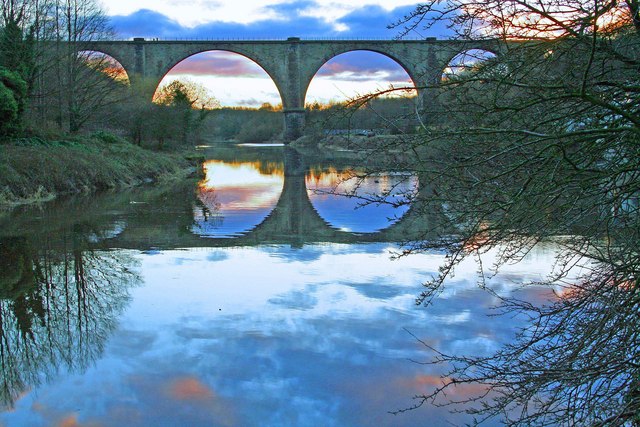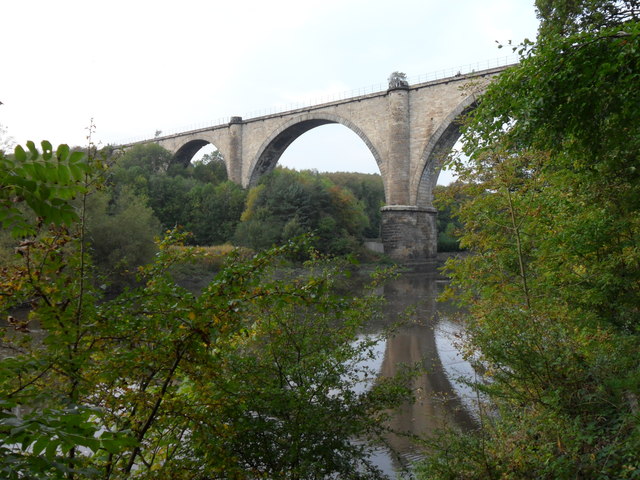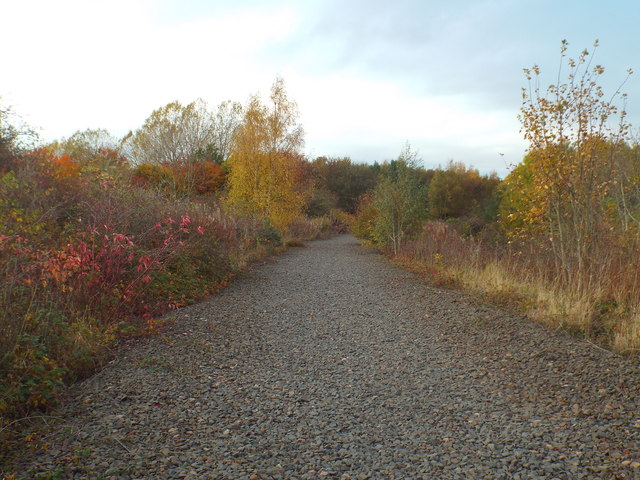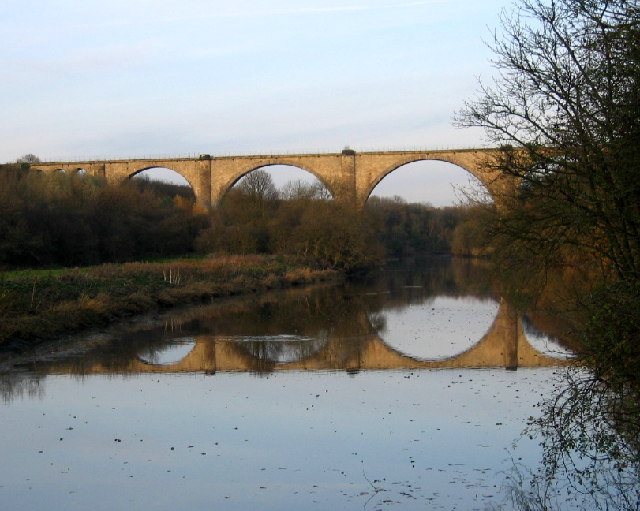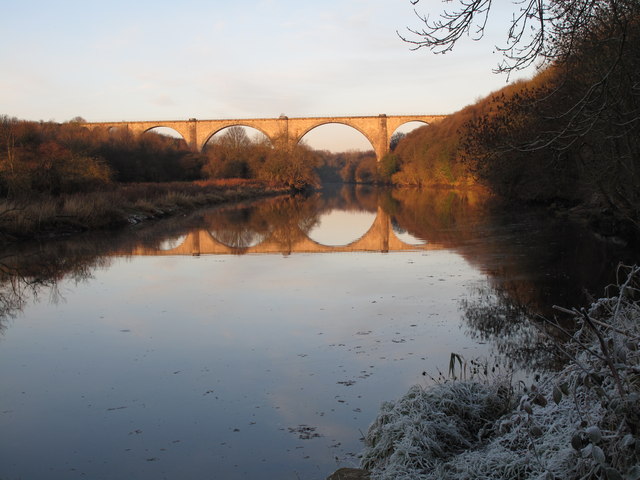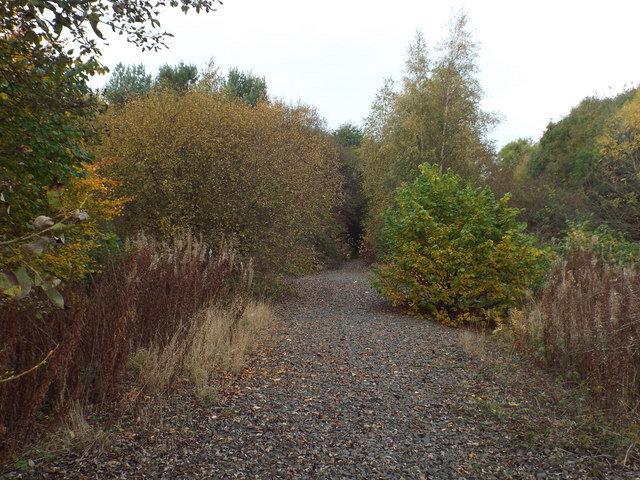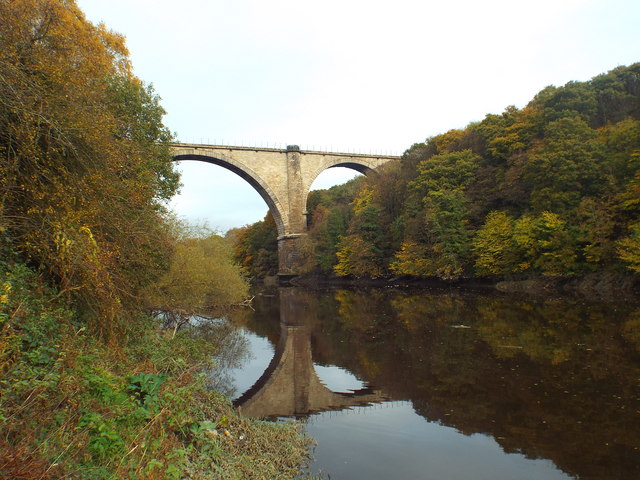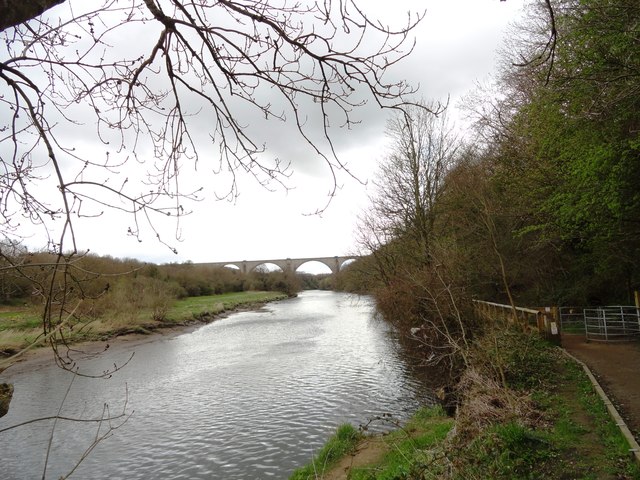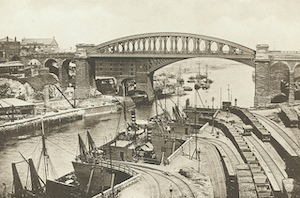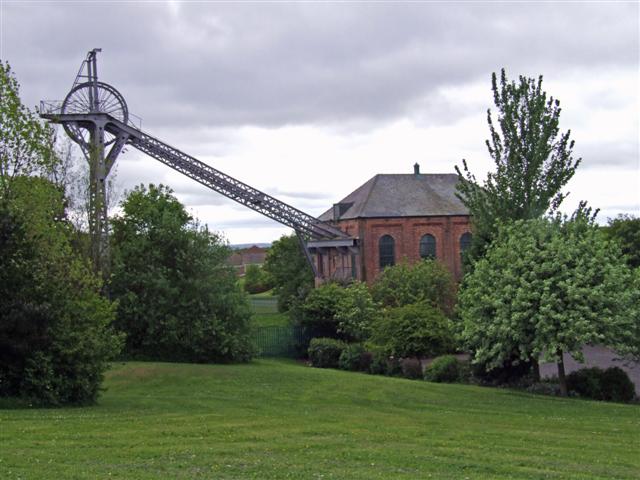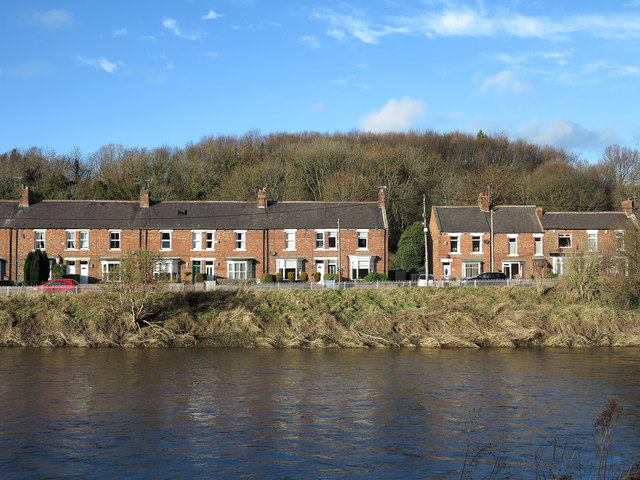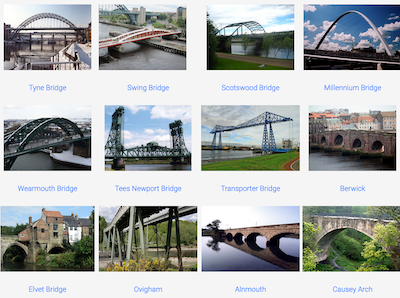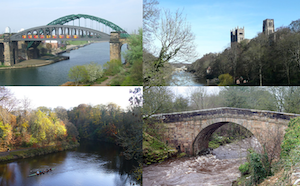Topics > Tyne and Wear > Sunderland > Washington > Victoria Viaduct
Victoria Viaduct
Victoria Bridge is a 810 ft long rail viaduct over the River Wear near Fatfield, Washington. It was built for the Durham Junction Railway and opened on Queen Victoria's coronation day 28th June 1838. it carried the main London-Newcastle railway line until 1868. The viaduct by James Walker of Walker and Burges, was modelled on Trajan's bridge at Alcantara, in Spain, although not an exact copy.[1] The bridge was in use up to 1990, and mothballed in 1991, and finally closed in 2012. Victoria Bridge is Grade II* listed on the National Heritage List for England.
The Victoria Viaduct, originally known as the Victoria Bridge, is a stone arch rail viaduct spanning the River Wear in North East England, built as part of the Durham Junction Railway under the supervision of Thomas Elliot Harrison.
History and design
The bridge was constructed as part of the Durham Junction Railway, which had been sanctioned by act of parliament in 1834; the act allowed for traffic tolls on a bridge over the Wear, including tolls for road and foot crossing. A iron bridge suitable for passage by rail, foot and road vehicle was designed by John Green of Newcastle, but instead a stone arch bridge designed by James Walker was chosen. The contract to build the bridge was given to John Gibb & Son. of Aberdeen.
The design was based upon the Alcántara Bridge in Spain. Construction began 17 March 1836 and was completed on 28 June 1838, the date of the coronation of Queen Victoria; as a result it was called 'Victoria Bridge'. The cost of construction was £40,338 5s. 10d.
The bridge was 810 ft 9 in (247.12 m) in length and 23 ft 4 in (7.11 m) in width, with a height above water level of the top point of the arches of approximately 120 ft (37 m). It was constructed entirely of locally quarried Penshaw sandstone, excluding the quoins stones of the main arches, made of aberdeen granite. The viaduct carried a double track railway, and had a walkway on either side for pedestrians.
The main arches had spans of 100 ft (30 m); 160 ft (49 m); 144 ft (44 m); and 100 ft (30 m). At either end of the viaduct were sets of three smaller spans of 20 ft (6.1 m). The main arches were semicircular with the exception of the main 160 ft span, which was a circular segment, spanning 160 ft with a rise of 72 ft. The three main piers and one of the arch abutments were founded on bedrock, the river pier required excavation to a depth of below the river bed to obtain that footing. One arch abutment was founded on long, diameter scotch fir piles, spaced at 3 ft (0.91 m). Above the first 5 ft (1.5 m) the piers contained voids to minimise mass.
The bridge and line opened in August 1838. As built it was one of the largest bridges in Europe, being exceeded in arch length by the River Dee bridge at Chester, and in height by the Alacantra bridge, but not by other structures in both dimensions.
Scheduled passenger trains on the line and viaduct ceased in 1964 following the Beeching Axe. The bridge continued to carry freight, and was renovated in 1989/90. Diverted passenger trains also used it occasionally, especially while the East Coast Main Line was being electrified. After closure of the freight terminal at Follingsby in 1991 the line and bridge were mothballed. However, the line was closed in 2012. The structure was grade II* listed in 1985.
Visit the page: Victoria Viaduct for references and further details. You can contribute to this article on Wikipedia.

from https://historicengland.org.u…
VICTORIA RAILWAY BRIDGE - Sunderland - List Entry
- "Railway bridge. 1838 by James Walker of Walker and Burges. Rusticated sandstone. 4 main arches, the most southerly spanning the Wear, and 3 minor at each end : main spans …
Added by
Simon Cotterill

from https://commons.wikimedia.org…
Woodcut of construction of the "Victoria bridge"
- From "The Local Historian's Table Book of remarkable occurrences...: Historical division, vol. V (1846)" Public domain image c/o Wikimedia Commons.
Added by
Simon Cotterill
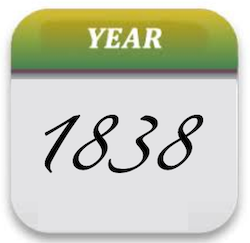
Co-Curate Page
1838
- < 1837 | 1838 | 1839 > In Northern England: 2nd February 1838: Charles Dickens visits Barnard Castle whilst researching his novel, Nicholas Nickleby. 18th of June 1838: official opening of the Newcastle and Carlisle …


from https://historicengland.org.u…
VICTORIA RAILWAY BRIDGE - Sunderland - List Entry
- "Railway bridge. 1838 by James Walker of Walker and Burges. Rusticated sandstone. 4 main arches, the most southerly spanning the Wear, and 3 minor at each end : main spans …
Added by
Simon Cotterill

from https://commons.wikimedia.org…
Woodcut of construction of the "Victoria bridge"
- From "The Local Historian's Table Book of remarkable occurrences...: Historical division, vol. V (1846)" Public domain image c/o Wikimedia Commons.
Added by
Simon Cotterill

Co-Curate Page
1838
- < 1837 | 1838 | 1839 > In Northern England: 2nd February 1838: Charles Dickens visits Barnard Castle whilst researching his novel, Nicholas Nickleby. 18th of June 1838: official opening of the Newcastle and Carlisle …
List grade: 2*
Grid ref: NZ3201454540
Borough: Sunderland
Wikipedia: Victoria Viaduct

